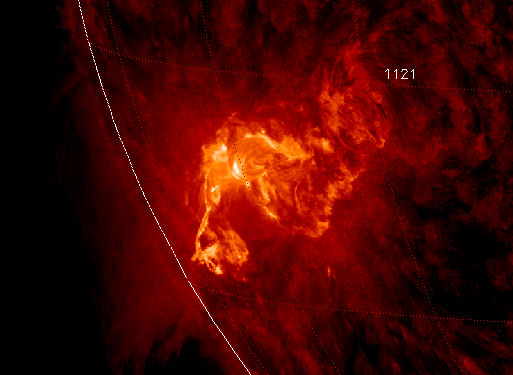Solar wind
speed: 376.9 km/sec
density: 0.2 protons/cm3
explanation | more data
Updated: Today at 1116 UT
|
|
6-hr max: B2 0838 UT Nov30
24-hr: B3 0134 UT Nov30
explanation | more data
Updated: Today at: 1100 UT
LONG-DELAY RADIO ECHOES:
During the geomagnetic storm of Nov. 27th, a brief but intense G2-class event, amateur radio operator Peter Brogl of Fürth, Germany experienced a strange phenomenon. Forty-six seconds after he transmitted his call sign at 7 MHz, he received an echo of his own transmission. "At first, I thought someone was playing tricks on me," says Brogl, "but I changed frequency, re-keyed my call sign (DK6NP), and got another echo." This went on for more than an hour, enough time for Brogl to make several recordings. First reported in 1927 by Norwegian civil engineer Jørgen Hals, long-delay radio echoes are rare and poorly understood. Unusual propagation conditions linked to solar storms is one of many possible explanations.SUNSPOT CANOPY:
Two days ago, sunspot 1130 didn't exist. Now the fast-growing sunspot group is the largest visible feature on the sun's disk with twin cores both larger than Earth. The amazing thing, however, is the invisible part. Using extreme ultraviolet filters outside the range of human vision, NASA's Solar Dynamics Observatory took this picture of the sunspot's magnetic canopy on Nov. 30th:
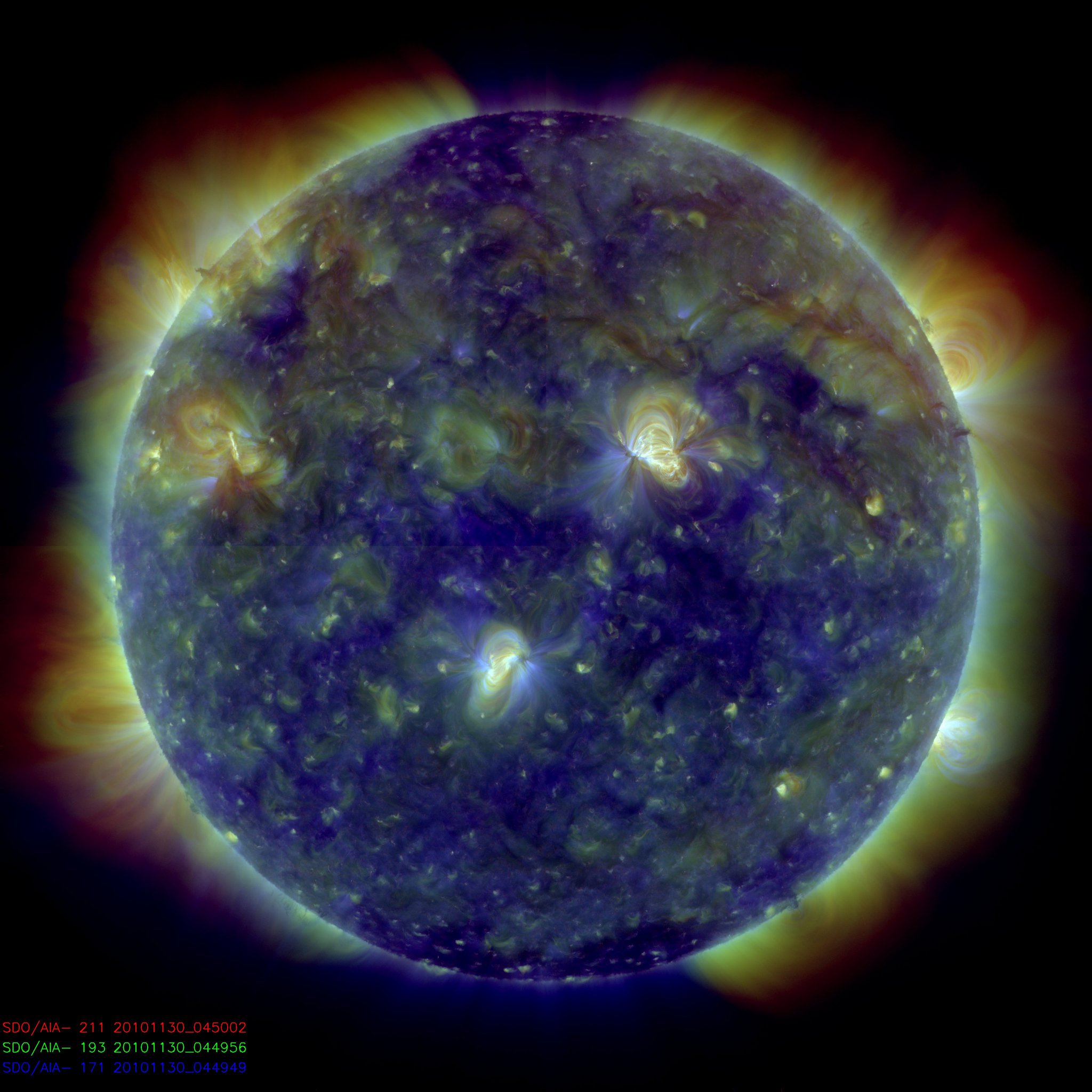
In the image, curvaceous lines of magnetism are illuminated by hot solar plasma trapped inside the canopy. If the magnetic field becomes unstable and explodes, as sunspot magnetic fields tend to do, a cloud of plasma could come flying toward Earth. This active region merits watching for the next few days until the sun's rotation turns it away from our planet.
Solar wind
speed: 367.5 km/sec
density: 0.7 protons/cm3
explanation | more data
Updated: Today at 2346 UT
|
|
6-hr max: B1 1939 UT Nov29
24-hr: B2 1447 UT Nov29
explanation | more data
Updated: Today at: 2300 UT
NEW SUNSPOT: New sunspot 1130 is rapidly developing near the center of the sun's disk and "it is crackling with activity," reports Michael Borman of Evansville, Indiana. Using a backyard solar telescope, he took this picture of a B-class explosion from the active region on Nov. 28th. So far, the flares have been relatively minor, but if the sunspot's growth continues apace, geo-effective blasts could be in the offing.
|
|
Solar wind
speed: 442.0 km/sec
density: 0.3 protons/cm3
explanation | more data
Updated: Today at 2345 UT
|
|
6-hr max: B2 1754 UT Nov28
24-hr: B2 1754 UT Nov28
explanation | more data
Updated: Today at: 2300 UT
COMET HARTLEY 2:
Comet Hartley 2 is putting on a show for amateur astronomers. Tonight, the amazing green comet glides midway between two star clusters, M46 and M47, in the southern constellation Puppis. George Ionas of Palmerston North, New Zealand, made a two hour movie of the comet's approach on Nov. 28th. "This is a pretty sight in backyard telescopes as the comet stilll has a fairly bright nucleus," he says. Astrophotographers who wish to monitor the encounter can point their telescopes using this ephemeris and sky map.more images: from Rolando Ligustri and from J.D. Strikis, both using robotic telescopes in New Mexico
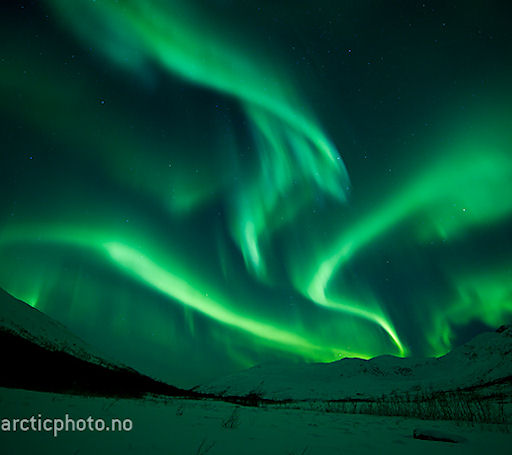
Solar wind
speed: 366.6 km/sec
density: 7.9 protons/cm3
explanation | more data
Updated: Today at 1746 UT
|
|
6-hr max: A7 1650 UT Nov27
24-hr: A7 1650 UT Nov27
explanation | more data
Updated: Today at: 1700 UT
SUNSPOT GENESIS:
A new sunspot is rapidly coelescing near the sun's southwestern limb today: finder chart. Readers with solar telescopes are encouraged to look. It's a nice opportunity to witness sunspot genesis in action.FARSIDE ACTIVITY:
The far side of the sun is alive with activity. On Nov. 26th, NASA's twin STEREO spacecraft and the Solar and Heliospheric Observatory (SOHO) observed two farside coronal mass ejections (CMEs) billowing into space. This one came from old sunspot 1126, located just over the sun's southwestern horizon:Hours later, a second CME followed, but not from the same blast site. The second CME came from an active region near the sun's anti-Earth point, almost directly opposite our planet on the solar farside. If Earth were on the other side of the sun, we would be be expecting bright auroras from the impact of these clouds. Instead, the alert is for "all quiet." Nothing major is heading our way.
The farside active regions that produced these eruptions will turn to face Earth in 7 to 14 days. Will they remain active that long? Stay tuned for updates.
more movies: (1) Both CMEs observed by STEREO-B; (2) The eruption of old sunspot 1126 observed by STEREO-A. Watch the STEREO-A movie all the way to the end. The eruption occurs in the final third of the movie.
FARSIDE ACTIVITY: The far side of the sun is alive with activity. Today, NASA's twin STEREO spacecraft and the Solar and Heliospheric Observatory (SOHO) have observed two farside coronal mass ejections (CMEs) billowing into space. This one came from old sunspot 1126, located just over the sun's southwestern horizon:
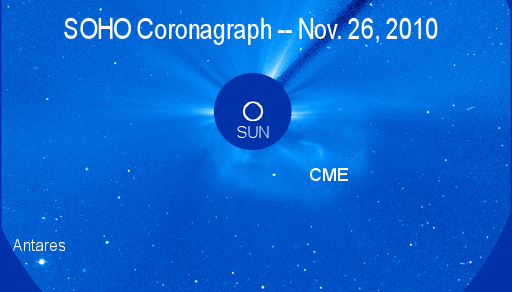
Click to play a 3 MB gif animation
Hours later, a second CME followed, but not from the same blast site. The second CME came from an active region near the sun's anti-Earth point, almost directly opposite our planet on the solar farside.
If Earth were on the other side of the sun, we would be be expecting bright auroras from the impact of these clouds. Instead, the alert is for "all quiet." Nothing major is heading our way.
The farside active regions that produced these eruptions will turn to face Earth in 7 to 14 days. Will they remain active that long? Stay tuned for updates from the farside.
Solar wind
speed: 338.4 km/sec
density: 1.5 protons/cm3
explanation | more data
Updated: Today at 2345 UT
|
|
6-hr max: A5 1834 UT Nov26
24-hr: A6 0000 UT Nov26
explanation | more data
Updated: Today at: 2300 UT
|
|
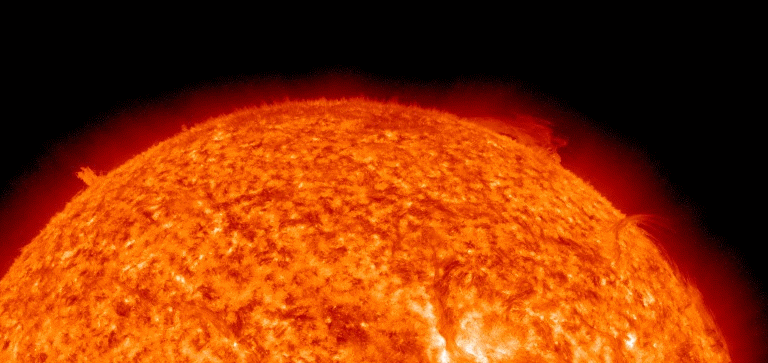
Solar wind
speed: 426.0 km/sec
density: 0.2 protons/cm3
explanation | more data
Updated: Today at 2345 UT
|
|
6-hr max: B3 2130 UT Nov25
24-hr: B3 2130 UT Nov25
explanation | more data
Updated: Today at: 2300 UT
Solar wind
speed: 465.2 km/sec
density: 1.2 protons/cm3
explanation | more data
Updated: Today at 2345 UT
|
|
6-hr max: B1 1723 UT Nov24
24-hr: B1 1723 UT Nov24
explanation | more data
Updated: Today at: 2300 UT
ALIEN COMETS IN THE SOLAR SYSTEM: Some of the comets in our Solar System probably came from other stars, according to new research by NASA-supported scientists. Studying these 'alien' comets, they say, could reveal new information about stellar systems far, far away. Get the full story from Science@NASA.
|
|
X-ray Solar Flares
6-hr max: C1 1700 UT Nov23
24-hr: M9 2330 UT Nov22
explanation | more data
Updated: Today at 2245 UT
RADIATION STORM: The Thanksgiving Day explosion near sunspot 9704 also sparked an M9.9-class solar flare. Energetic protons accelerated by the flare and by the incoming CME are streaming past Earth in great numbers. As a result, a strong S3-class radiation storm is in progress around our planet.
Solar Wind
velocity: 456.5 km/s
density:3.4 protons/cm3
explanation | more data
Updated: Today at 2245 UT
X-ray Solar Flares
6-hr max: M3 2035 UT Nov22
24-hr: M3 2035 UT Nov22
explanation | more data
Updated: Today at 2245 UT
Solar wind
speed: 401.4 km/sec
density: 1.0 protons/cm3
explanation | more data
Updated: Today at 1044 UT
|
|
6-hr max: B1 0421 UT Nov21
24-hr: B1 0054 UT Nov21
explanation | more data
Updated: Today at: 1000 UT
LEONID RECAP: Earth is exiting a thicket of debris from Comet Tempel-Tuttle, source of the annual Leonid meteor shower. According to international counts, the shower crested on Nov. 17th and 18th with a peak rate of 20 meteors per hour. Compared to, say, the Leonid storms of a decade ago, it was not an impressive display--that is, unless you added it up for five nights in a row:
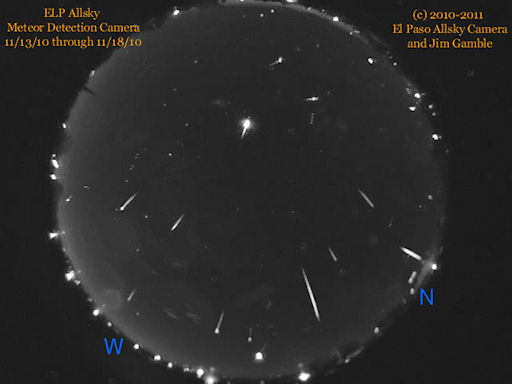
These are all the Leonid fireballs I recorded from Nov. 13th to Nov. 18th," says Jim Gamble, who operates an all-sky camera in El Paso, Texas. "In total, there were 16 Leonids of magnitude -3 or brighter." Considering that Earth missed the densest part of the Leonid debris stream in 2010, more than a dozen fireballs is a good haul.
A bigger display is coming: In early December, Earth will enter a cloud of debris from extinct comet Phaethon, setting off the annual Geminid meteor shower. On peak night, Dec. 14th, forecasters expect as many as 100 meteors per hour, five times greater than the waning Leonids. Stay tuned!
more images: from Yuichi Takasaka of Gingolx (Kincolith), British Columbia, Canada; from Thomas Kerns of Homer, Alaska; from Yaron Eini of Jerusalem, Israel;
Solar wind
speed: 412.8 km/sec
density: 0.4 protons/cm3
explanation | more data
Updated: Today at 1836 UT
|
|
6-hr max: B1 1643 UT Nov20
24-hr: B2 0428 UT Nov20
explanation | more data
Updated: Today at: 1800 UT
They are saying "Another doomed comet". I'm seeing UFOs too.
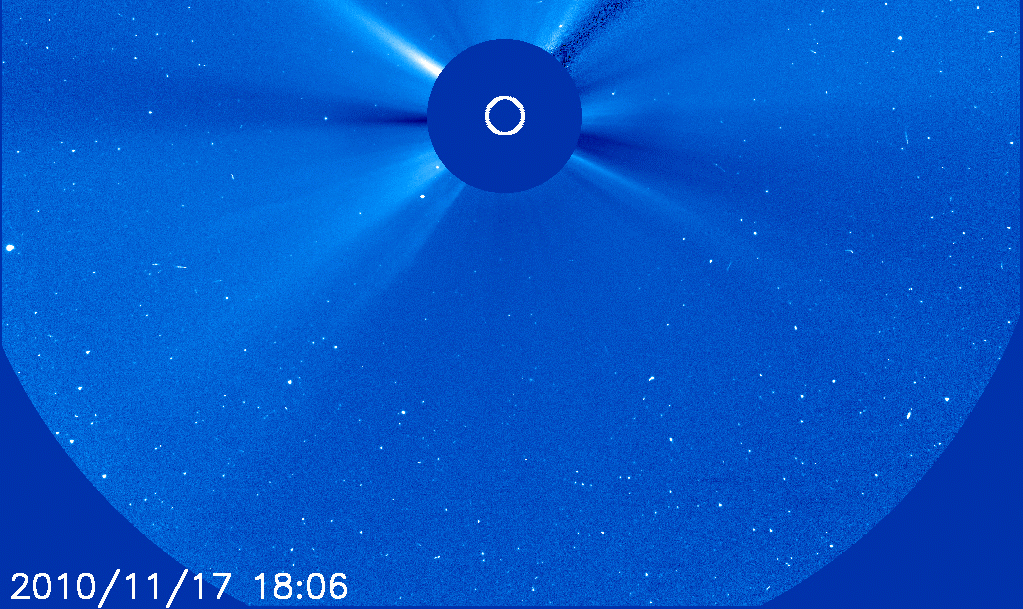
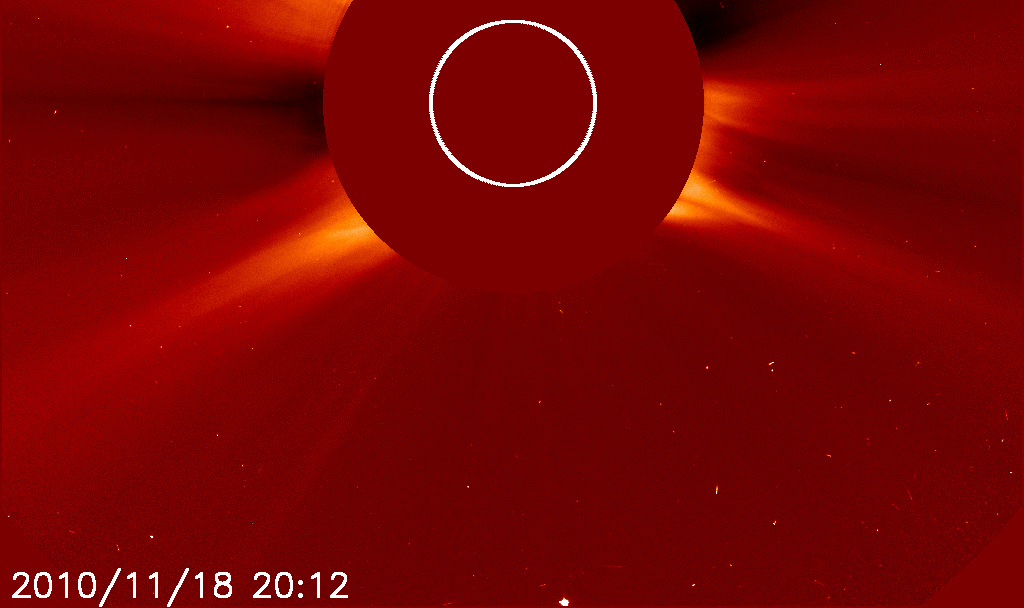
Play it again and note how the head of the comet is shrinking and dimming. The icy visitor from the outer solar system is evaporating before our very eyes.
On Nov. 14th, another comet followed the same path and met the same fate. It's no coincidence. Both are fragments of a giant parent comet that broke apart about 2000 years ago. Astronomers call them "Kruetz sungrazers" after the 19th century German researcher, Heinrich Kreutz, who studied them in detail. According to some estimates, several Kruetz comets pass by the sun and disintegrate every day. Most are too small to see, but occasionally a large fragment (or two) attracts attention.
11-18-10 sunspots 1124. 1125
Solar wind
speed: 557.3 km/sec
density: 0.7 protons/cm3
explanation | more data
Updated: Today at 2345 UT
6-hr max: B2 2051 UT Nov18
24-hr: B4 0653 UT Nov18
explanation | more data
Updated: Today at: 2300 UT
Comet Snowstorm Engulfs Hartley 2
Nov. 18, 2010: NASA has just issued a travel advisory for spacecraft: Watch out for Comet Hartley 2, it is experiencing a significant winter snowstorm.
Deep Impact photographed the unexpected tempest when it flew past the comet's nucleus on Nov. 4th at a distance of only 700 km (435 miles). At first, researchers only noticed the comet's hyperactive jets. The icy nucleus is studded with them, flamboyantly spewing carbon dioxide from dozens of sites. A closer look revealed an even greater marvel, however. The space around the comet's core is glistening with chunks of ice and snow, some of them possibly as large as a basketball.

"We've never seen anything like this before," says University of Maryland professor Mike A'Hearn, principal investigator of Deep Impact's EPOXI mission. "It really took us by surprise."
Before the flyby of Hartley 2, international spacecraft visited four
other comet cores—Halley, Borrelly, Wild 2, and Tempel 1. None was
surrounded by "comet snow." Tempel 1 is particularly telling because
Deep Impact itself performed the flyby. The very same high resolution,
high dynamic range cameras that recorded snow-chunks swirling around
Hartley 2 did not detect anything similar around Tempel 1.
"This is a genuinely new phenomenon," says science team member Jessica Sunshine of the University of Maryland. "Comet Hartley 2 is not like the other comets we've visited."
The 'snowstorm' occupies a roughly-spherical volume centered on Hartley 2's spinning nucleus. The dumbbell-shaped nucleus, measuring only 2 km from end to end, is tiny compared to the surrounding swarm. "The ice cloud is a few tens of kilometers wide--and possibly much larger than that," says A'Hearn. "We still don't know for sure how big it is."
Data collected by Deep Impact's onboard infrared spectrometer show without a doubt that the particles are made of frozen H2O, i.e., ice. Chunks consist of micron-sized ice grains loosely stuck together in clumps a few centimeters to a few tens of centimeters wide.
MORE AT: http://science.nasa.gov/science-news/science-at-nasa/2010/18nov_cometsnowstorm/
Solar wind
speed: 346.6 km/sec
density: 0.2 protons/cm3
explanation | more data
Updated: Today at 1946 UT
6-hr max: B2 1847 UT Nov19
24-hr: B2 1847 UT Nov19
explanation | more data
Updated: Today at: 1900 UT
Solar wind
speed: 500.3 km/sec
density: 0.0 protons/cm3
explanation | more data
Updated: Today at 2345 UT
|
|
6-hr max: B3 2255 UT Nov16
24-hr: B4 0038 UT Nov16
explanation | more data
Updated: Today at: 2300 UT
Solar wind
speed: 500.3 km/sec
density: 0.0 protons/cm3
explanation | more data
Updated: Today at 2345 UT
|
|
6-hr max: B3 2255 UT Nov16
24-hr: B4 0038 UT Nov16
explanation | more data
Updated: Today at: 2300 UT
Solar wind
speed: 725.0 km/sec
density: 0.6 protons/cm3
explanation | more data
Updated: Today at 2345 UT
|
|
6-hr max: B2 2206 UT Nov14
24-hr: C1 0001 UT Nov14
explanation | more data
Updated: Today at: 2300 UT
LEONID METEOR SHOWER: The annual Leonid meteor shower peaks this year on Nov. 17th when Earth passes through a thicket of debris from Comet Tempel-Tuttle. Earth is expected to miss the densest swarms of comet dust, making this an off-year for Leonids with a maximum of only 20 meteors per hour.
Solar wind
speed: 725.0 km/sec
density: 0.6 protons/cm3
explanation | more data
Updated: Today at 2345 UT
|
|
6-hr max: B2 2206 UT Nov14
24-hr: C1 0001 UT Nov14
explanation | more data
Updated: Today at: 2300 UT
SUNDIVING COMET: The solar system has one less comet today after one of the dirty snowballs swung past the sun--a little too close--and did not survive. Click on the image to view a movie of the death plunge
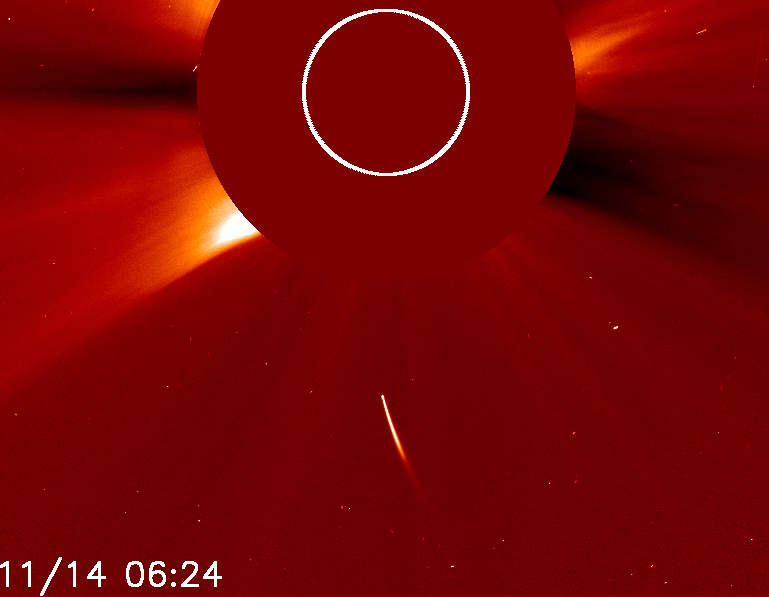
Solar wind
speed: 524.8 km/sec
density: 0.3 protons/cm3
explanation | more data
Updated: Today at 0956 UT
|
|
6-hr max: C1 0811 UT Nov12
24-hr: C4 0134 UT Nov12
explanation | more data
Updated: Today at: 1000 UT
EARTH-DIRECTED ERUPTION:
Active sunspot 1123 erupted during the early hours of Nov. 12th, producing a C4-class solar flare and apparently hurling a filament of material in the general direction of Earth. Click on the image to play a three and a half hour (0000 - 0330 UT) time lapse movie of the event:
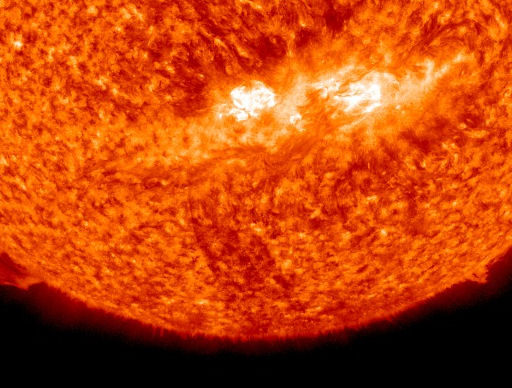
Movie formats:
1.4 MB gif,
0.5 MB iPad,
0.3 MB iPhone. Credit: SDO
C
oronagraph images from NASA's twin STEREO spacecraft show a coronal mass ejection (CME) emerging from the blast site and heading off in a direction just south of the sun-Earth line. The cloud could deliver a glancing blow to Earth's magnetic field sometime on Nov. 14th or 15th, sparking auroras. Stay tuned for refined predictions later today when SOHO images of the CME become available.JUPITER'S MISSING STRIPE, RETURNING?
Earlier this year when Jupiter's great South Equatorial Belt (SEB) vanished, researchers urged amateur astronomers to be alert for its eventual return. The SEB had come and gone before, they noted, and the revival was something to behold. Alert: It might be happening now. After months of quiet in Jupiter's south equatorial zone, a white plume is surging through the cloudtops where the SEB should be. Christopher Go of the Philippines took this picture on Nov. 9th:
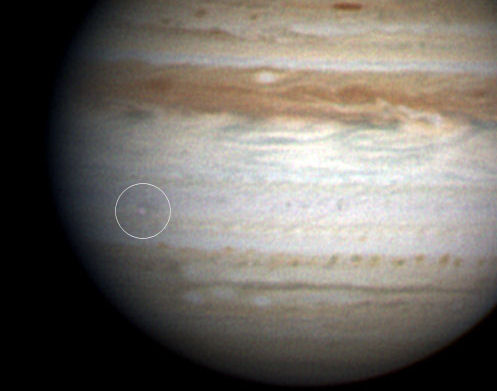
I
t might not look like much, but this is how a revival of the SEB begins--a small disturbance in the upper atmosphere heralds a much larger profusion of spots and swirls bursting forth around the whole circumference of the giant planet. Amid the confusion, Jupiter's vast brown stripe emerges.Subsequent observations by astronomers in the United States, Japan, and the Philippines not only confirm the plume, but also show it brightening rapidly. Indeed, as Nov. 12th unfolds, it is the single brightest spot on Jupiter in wavebands ranging from infrared to ultraviolet.
"This plume is so energetic that we can confidently expect it to develop into the SEB Revival," says John Rogers, director of the Jupiter section of the British Astronomical Association. "The SEB Revival is usually spectacular, so we can expect impressive and rapidly changing disturbances over the next 3 months."
Experienced planetary photographers are encouraged to monitor developments. If events proceed apace, the Revival could become visible to novices using small backyard telescopes, so stay tuned.
speed: 457.9 km/sec
density: 1.1 protons/cm3
explanation | more data
Updated: Today at 2340 UT
|
|
6-hr max: C1 1942 UT Nov11
24-hr: C4 0724 UT Nov11
explanation | more data
Updated: Today at: 2300 UT
JUPITER'S MISSING STRIPE, RETURNING? Earlier this year when Jupiter's great South Equatorial Belt (SEB) vanished, researchers urged amateur astronomers to be alert for its eventual return. The SEB had come and gone before, they noted, and the revival was something to behold. Alert: It might be happening now. After months of quiet in Jupiter's south equatorial zone, a white plume is surging through the cloudtops where the SEB should be. Christopher Go of the Philippines took this picture on Nov. 9th:
It might not look like much, but this is how a revival of the SEB begins--a small disturbance in the upper atmosphere heralds a much larger profusion of spots and swirls bursting forth around the whole circumference of the giant planet. Amid the confusion, Jupiter's vast brown stripe emerges.
Subsequent observations by astronomers in the United States, Japan, and the Philippines not only confirm the plume, but also show it brightening rapidly. Indeed, as Nov. 11th unfolds, it is the single brightest spot on Jupiter in wavebands ranging from infrared to ultraviolet.
"This plume is so energetic that we can confidently expect it to develop into the SEB Revival," says John Rogers, director of the Jupiter section of the British Astronomical Association. "The SEB Revival is usually spectacular, so we can expect impressive and rapidly changing disturbances over the next 3 months."
Experienced planetary photographers are encouraged to monitor developments. If events proceed apace, the Revival could become visible to novices using small backyard telescopes, so stay tuned.
CRACKLING SUNSPOTS: Sunspot complex 1121-1123 crackling with C-class solar flares, producing more than five such eruptions in the past 24 hours. With so much activity going on, it is easy to catch the region in mid-flare, as Michael Buxton did this morning from his backyard observatory in Ocean Beach, California
Solar wind
speed: 313.1 km/sec
density: 1.8 protons/cm3
explanation | more data
Updated: Today at 2345 UT
|
|
6-hr max: B6 2255 UT Nov10
24-hr: B9 1639 UT Nov10
explanation | more data
Updated: Today at: 2300 UT
ACTIVITY ON JUPITER:
Earlier this year when Jupiter's great South Equatorial Belt (SEB) vanished, researchers urged amateur astronomers to be alert for its eventual return. The SEB had come and gone before, they noted, and the revival was something to behold. Alert: It might be happening now. After months of quiet in Jupiter's south equatorial zone, a white spot is rapidly forming where the SEB should be. Christopher Go of the Philippines took this picture on Nov. 9th:It might not look like much, but this is how a revival of the SEB begins--a small disturbance in the upper atmosphere heralds a sudden profusion of spots and swirls. Amid the confusion, Jupiter's vast brown stripe emerges.
The existence of this spot has reportedly been confirmed by astrophotographer Donald Parker of Coral Gables, Florida, and Go himself saw it again on Nov. 10th. "The 'SEB outbreak spot' is also prominent in ultraviolet and methane band filters," notes Go. "This spot should grow bigger in the coming days."
Experienced planetary photographers are encouraged to monitor Jupiter for further developments.Solar wind
speed: 365.2 km/sec
density: 0.0 protons/cm3
explanation | more data
Updated: Today at 2323 UT
|
|
6-hr max: B1 1842 UT Nov09
24-hr: B3 1400 UT Nov09
explanation | more data
Updated: Today at: 2300 UT
COMET OUTBURST:
Comet Ikeya-Murakami (C/2010 V1) is definitely undergoing an outburst event. Italian astronomers Ernesto Guido and Giovanni Sostero assembled the following animation from images they obtained between Nov. 4th and Nov 9th: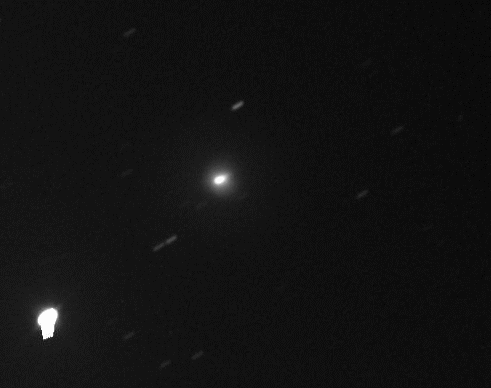
The sequence clearly shows an explosion in progress. "Only Nov. 7th is missing," they say, "because of rare cloudy skies over New Mexico, where the remotely-controlled telescope we used is located."
Another New Mexico observer, Leonid Elenin, estimates the size of comet's expanding atmosphere as 4x6 arcminutes. "There is also some evidence of two symmetrical jets emerging from the nucleus of the comet," he says.
The behavior of this comet reminds many onlookers of exploding Comet Holmes in 2007. Researchers believe Holmes exploded when an icy cavern in the comet's nucleus collapsed. Perhaps something similar has happened to Comet Ikeya-Murakami. The icy visitor from the outer solar system made its closest approach to the Sun in late October, so it has just received a dose of solar heating that could trigger such an event.
Amateur astronomers are encouraged to monitor developments. Various reports put the brightness of the comet between 7th and 9th magnitude, invisible to the naked eye but an easy target for telescopes such as the Comet Hunter. It's easy to find, too, little more than a degree from Saturn in the eastern sky before dawn. Set your alarm and happy hunting! [Sky maps: Nov. 9, 10, 11] [3D orbit] [ephemeris]
more images: from Joseph Brimacombe using a robotic telescope in New Mexico (Nov.8); from Gil Esquerdo of Whipple Observatory, Mt. Hopkins, Arizona (Nov. 8); from Tenho Tuomi of Lucky Lake, SK, Canada (Nov. 7); from Gregg Ruppel of Ellisville, Missouri (Nov. 7); from Feys Filip of Crete, Greece (Nov. 6); from Gregg Ruppel of Ellisville, Missouri (Nov. 6); from Gregg Ruppel of Ellisville, Missouri (Nov. 5); from Luca Buzzi of the G.V. Schiaparelli Astronomical Observatory in Varese, Italy (Nov. 4);
Solar wind
speed: 315.6 km/sec
density: 0.3 protons/cm3
explanation | more data
Updated: Today at 2344 UT
|
|
6-hr max: B1 2251 UT Nov08
24-hr: B1 0239 UT Nov08
explanation | more data
Updated: Today at: 2300 UT
SOLAR ACTIVITY UPDATE:
After unleashing one of the brightest X-ray flares in years on Saturday, Nov. 6th, sunspot 1121 took Sunday off. No strong flares were recorded for the rest of the weekend. Nevertheless, the active region's magnetic field is complex and harbors energy for more eruptions. NOAA forecasters estimate an 85% chance of M-flares during the next 24 hours.NEW COMET IKEYA-MURAKAMI:
Newly-discovered comet C/2010 V1 (Ikeya-Murakami) is putting on a good show for anyone with a backyard telescope and an alarm clock. The clock is for getting up before dawn, and the telescope is for seeing this:
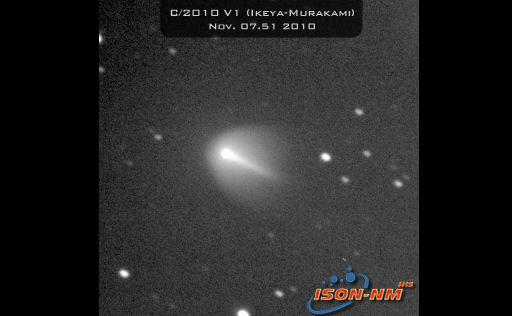
Leonid Elenin took the picture on Nov. 7th using a robotic telescope in New Mexico. "The comet is rapidly changing," he reports. "The shape of its atmosphere reminds me of Comet Holmes after it had an outburst in 2007."
Indeed, Comet Ikeya-Murakami might be experiencing a similar event. The icy visitor from the outer solar system made its closest approach to the sun (1.7 AU) in late October, so it has recently received a strong dose of solar heating. Ice pockets could be evaporating, comet-caverns collapsing, who knows?
Amateur astronomers are encouraged to monitor developments. Various reports put the brightness of the comet between 7th and 9th magnitude, invisible to the naked eye but an easy target for telescopes such as the Comet Hunter. It's easy to find, too, little more than a degree from Saturn in the eastern sky before dawn. Set your alarm and happy hunting! [Sky maps: Nov 8, 9, 10, 11] [3D orbit] [ephemeris]
more images: from Gil Esquerdo of Whipple Observatory, Mt. Hopkins, Arizona (Nov. 8); from Tenho Tuomi of Lucky Lake, SK, Canada (Nov. 7); from Gregg Ruppel of Ellisville, Missouri (Nov. 7); from Feys Filip of Crete, Greece (Nov. 6); from Gregg Ruppel of Ellisville, Missouri (Nov. 6); from Gregg Ruppel of Ellisville, Missouri (Nov. 5); from Luca Buzzi of the G.V. Schiaparelli Astronomical Observatory in Varese, Italy (Nov. 4);
Solar wind
speed: 285.3 km/sec
density: 1.1 protons/cm3
explanation | more data
Updated: Today at 2344 UT
|
|
6-hr max: B3 1829 UT Nov07
24-hr: C5 0141 UT Nov07
explanation | more data
Updated: Today at: 2300 UT
M5 SOLAR FLARE:
Active sunspot 1121 has unleashed one of the brightest x-ray solar flares in years, an M5.4-class eruption at 15:36 UT on Nov. 6th. Click on the image to view a movie of the blast from NASA's Solar Dynamics Observatory:
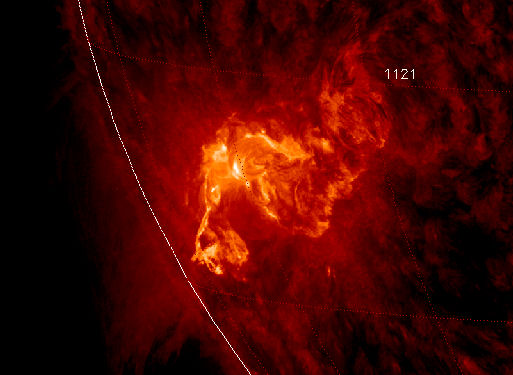
Radiation from the flare created a wave of ionization in Earth's upper atmosphere that altered the propagation of low-frequency radio waves. There was, however, no bright CME (plasma cloud) hurled in our direction, so the event is unlikely to produce auroras in the nights ahead. This is the third M-flare in as many days from this increasingly active sunspot. So far none of the eruptions has been squarely Earth-directed, but this could change in the days ahead as the sun's rotation turns the active region toward our planet.
more images:
from Thomas Ashcraft near Santa Fe, New Mexico; from Rogerio Marcon of Campinas SP Brasil; from Robert Arnold of Isle of Skye, Scotland; from James Kevin Ty of Manila, the Philippines;ACTIVE SUNSPOT: NOAA forecasters say there is a 70% chance of M-class solar flares during the next 24 hours. The source of the blast would be active region 1121 emerging over the sun's eastern limb:
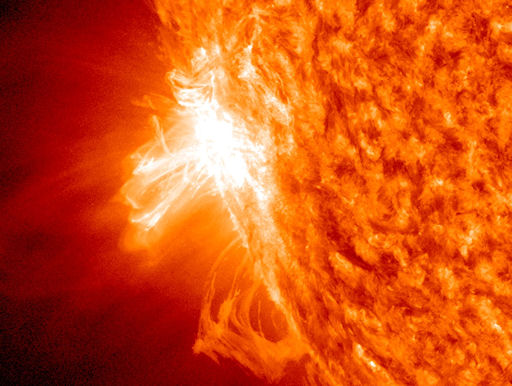
Image credit:
Solar Dynamics Observatory [larger
image]
Indeed, AR1121 is already crackling with an M2-flare on Nov. 4th and an M1-flare on Nov. 5th. So far none of the flares has been geo-effective, but this could change as the sun's rotation turns the blast site toward Earth in the days ahead. Readers with solar telescopes are encouraged to monitor developments.
more images: from Rogerio Marcon of Campinas SP Brasil; from Robert Arnold of Isle of Skye, Scotland; from James Kevin Ty of Manila, the Philippines
Solar wind
speed: 288.6 km/sec
density: 0.7 protons/cm3
explanation | more data
Updated: Today at 1556 UT
|
|
6-hr max: C1 0901 UT Nov06
24-hr: C4 0447 UT Nov06
explanation | more data
Updated: Today at: 1500 UT
|
|
M5 SOLAR FLARE: Active sunspot 1121 has just unleashed one of the brightest x-ray solar flares in years, an M5.4-class eruption at 15:36 UT on Nov. 6th. Click on the image to view a movie of the blast from NASA's Solar Dynamics Observatory:
Radiation from the flare created a wave of ionization in Earth's upper atmosphere that altered the propagation of low-frequency radio waves. There was, however, no bright CME (plasma cloud) hurled in our direction, so the event is unlikely to produce auroras in the nights ahead. This is the third M-flare in as many days, and the strongest, from this increasingly active sunspot. So far none of the eruptions has been squarely Earth-directed, but this could change in the days ahead as the sun's rotation turns the active region toward our planet. Now might be a good time to sign up for space weather alerts.
more images: from Thomas Ashcraft near Santa Fe, New Mexico; from Rogerio Marcon of Campinas SP Brasil; from Robert Arnold of Isle of Skye, Scotland; from James Kevin Ty of Manila, the Philippines;
NORTHERN LIGHTS: A minor geomagnetic storm on Nov. 4th made the ice crack in Norway. Actually, it was the weight of the photographer that did it. Ole Christian Salomonsen walked out on the water's frozen surface to get this shot:
Solar wind
speed: 297.8 km/sec
density: 0.1 protons/cm3
explanation |
more data
Updated: Today at 2344 UT
6-hr max: M1 1701 UT Nov06
24-hr: M5 1536 UT Nov06
explanation | more data
Updated: Today at: 2300 UT
|
Solar wind
speed: 297.8 km/sec density: 0.1 protons/cm3 explanation | more data Updated: Today at 2344 UT 6-hr max: M1 1701 UT Nov06 24-hr: M5 1536 UT Nov06 explanation | more data Updated: Today at: 2300 UT What is the sunspot number? Updated 04 Nov 2010 Spotless Days Current Stretch: 0 days 2010 total: 45 days (15%) 2009 total: 260 days (71%) Since 2004: 813 days Typical Solar Min: 486 days Updated 04 Nov 2010 The Radio Sun 10.7 cm flux: 79 sfu explanation | more data Updated 04 Nov 2010 Credit: NOAA/POES Now: Kp= 0 quiet 24-hr max: Kp= 1 quiet explanation | more data Btotal: 3.1 nT Bz: 1.4 nT south explanation | more data Updated: Today at 2345 UT 
Probabilities for significant disturbances in Earth's magnetic field are given for three activity levels: active, minor storm, severe storm
|
FARSIDE FLARE: An active region just over the sun's eastern horizon is crackling with solar flares and hurling material high above the stellar surface. This extreme ultraviolet movie from NASA's Solar Dynamics Observatory shows the strongest blast so far, a C4-class event at 1220 UT on Nov. 3rd:
movie formats: 3.8 MB mpeg, 0.9 MB iPad, 0.3 MB iPhone
Although the blast site is hidden behind the limb, the eruption nevertheless yielded enough x-radiation to produce a wave of ionization in Earth's upper atmosphere. Researcher Rob Stammes recorded a sudden ionospheric disturbance (SID) when the wave passed over his lab in Laukvik, Norway. Learn more about SIDs here.
The source of this activity is an old friend--a sunspot and magnetic filament jointly known as "active region 1112." The ensemble put on a good show in mid-October when it first crossed the face of the sun. For the past two weeks, however, it has been transiting the far side, out of sight. Today's eruption may be read as "hello, I'm back." The sun's rotation is bringing the region around for a second pass; readers with solar telescopes are encouraged to monitor the eastern limb for its emergence in the days ahead.
Solar wind
speed: 319.5 km/sec
density: 0.6 protons/cm3
explanation | more data
Updated: Today at 2344 UT
|
|
6-hr max: B5 2125 UT Nov03
24-hr: C4 1220 UT Nov03
explanation | more data
Updated: Today at: 2340 UT
RETURN OF THE MEGA-FILAMENT: Remember that spectacular mega-filament of magnetism sprawling across the sun's southern hemisphere in October? It's back....almost. For the past 10 days, the filament has been out of sight transiting the farside of the sun. This image from NASA's STEREO-B spacecraft suggests that the magnificent structure is about to return:
STEREO-B is stationed above the sun's eastern limb with a good view of things just over the horizon. The ultraviolet hotspot pictured above is where the filament would be if it is still intact. A continuing series of eruptions like this one might have decimated the structure, leaving it in tatters. We'll find out soon enough. Solar rotation is turning the region toward Earth and it should begin to be visible around Nov. 5th. Readers with solar telescopes are encouraged to monitor developmentsSolar wind
speed: 315.3 km/sec
density: 3.4 protons/cm3
explanation | more data
Updated: Today at 1745 UT
6-hr max: B1 1215 UT Nov02
24-hr: B2 1005 UT Nov02
explanation | more data
Updated: Today at: 1740 UT
BE ALERT FOR 'HARTLEY-ID' METEORS: If Comet Hartley 2 is going to produce a meteor shower, tonight is the night. According to experts, there is a slim chance that dust from the comet could hit Earth's atmosphere on Nov. 2nd and 3rd, producing a slow flurry of meteors streaming from the constellation Cygnus. If you're out after sunset, be alert for Hartley-ids.
Solar wind
speed: 312.7 km/sec
density: 1.2 protons/cm3
explanation | more data
Updated: Today at 2345 UT
|
|
6-hr max: B1 1555 UT Nov01
24-hr: C1 0440 UT Nov01
explanation | more data
Updated: Today at: 2340 UT
RADAR IMAGES OF COMET HARTLEY 2: What is the shape of nearby Comet Hartley 2? On October 24th, astronomers used the giant Arecibo radar to image the comet's core. And the answer is ... "a cross between a bowling pin and a pickle," reports Tim Larson of NASA's Jet Propulsion Laboratory. According to the radar images, the "pickle" is 2.2 km long and spins around it's short axis once every 18 hours. The Deep Impact (EPOXI) probe will get a closer look on Nov. 4th when it flies by the comet at a distance of only 435 miles. Stay tuned.
COMET UPDATE: Amateur astronomers report that they can once again see Comet Hartley 2 through backyard telescopes as the morning moon fades in brightness. latest images: #1, #2, #3.
DREAMS OF THE GREAT EARTHCHANGES - MAIN INDEX
